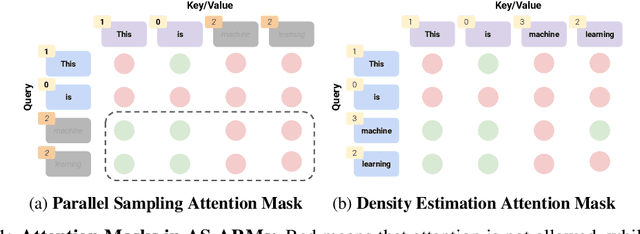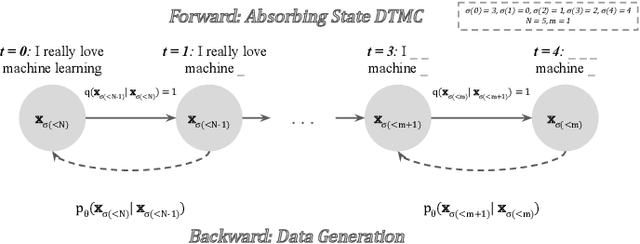Stefano Ermon
InfoTok: Adaptive Discrete Video Tokenizer via Information-Theoretic Compression
Dec 18, 2025Abstract:Accurate and efficient discrete video tokenization is essential for long video sequences processing. Yet, the inherent complexity and variable information density of videos present a significant bottleneck for current tokenizers, which rigidly compress all content at a fixed rate, leading to redundancy or information loss. Drawing inspiration from Shannon's information theory, this paper introduces InfoTok, a principled framework for adaptive video tokenization. We rigorously prove that existing data-agnostic training methods are suboptimal in representation length, and present a novel evidence lower bound (ELBO)-based algorithm that approaches theoretical optimality. Leveraging this framework, we develop a transformer-based adaptive compressor that enables adaptive tokenization. Empirical results demonstrate state-of-the-art compression performance, saving 20% tokens without influence on performance, and achieving 2.3x compression rates while still outperforming prior heuristic adaptive approaches. By allocating tokens according to informational richness, InfoTok enables a more compressed yet accurate tokenization for video representation, offering valuable insights for future research.
MeanFlow Transformers with Representation Autoencoders
Nov 17, 2025Abstract:MeanFlow (MF) is a diffusion-motivated generative model that enables efficient few-step generation by learning long jumps directly from noise to data. In practice, it is often used as a latent MF by leveraging the pre-trained Stable Diffusion variational autoencoder (SD-VAE) for high-dimensional data modeling. However, MF training remains computationally demanding and is often unstable. During inference, the SD-VAE decoder dominates the generation cost, and MF depends on complex guidance hyperparameters for class-conditional generation. In this work, we develop an efficient training and sampling scheme for MF in the latent space of a Representation Autoencoder (RAE), where a pre-trained vision encoder (e.g., DINO) provides semantically rich latents paired with a lightweight decoder. We observe that naive MF training in the RAE latent space suffers from severe gradient explosion. To stabilize and accelerate training, we adopt Consistency Mid-Training for trajectory-aware initialization and use a two-stage scheme: distillation from a pre-trained flow matching teacher to speed convergence and reduce variance, followed by an optional bootstrapping stage with a one-point velocity estimator to further reduce deviation from the oracle mean flow. This design removes the need for guidance, simplifies training configurations, and reduces computation in both training and sampling. Empirically, our method achieves a 1-step FID of 2.03, outperforming vanilla MF's 3.43, while reducing sampling GFLOPS by 38% and total training cost by 83% on ImageNet 256. We further scale our approach to ImageNet 512, achieving a competitive 1-step FID of 3.23 with the lowest GFLOPS among all baselines. Code is available at https://github.com/sony/mf-rae.
REAR: Rethinking Visual Autoregressive Models via Generator-Tokenizer Consistency Regularization
Oct 06, 2025Abstract:Visual autoregressive (AR) generation offers a promising path toward unifying vision and language models, yet its performance remains suboptimal against diffusion models. Prior work often attributes this gap to tokenizer limitations and rasterization ordering. In this work, we identify a core bottleneck from the perspective of generator-tokenizer inconsistency, i.e., the AR-generated tokens may not be well-decoded by the tokenizer. To address this, we propose reAR, a simple training strategy introducing a token-wise regularization objective: when predicting the next token, the causal transformer is also trained to recover the visual embedding of the current token and predict the embedding of the target token under a noisy context. It requires no changes to the tokenizer, generation order, inference pipeline, or external models. Despite its simplicity, reAR substantially improves performance. On ImageNet, it reduces gFID from 3.02 to 1.86 and improves IS to 316.9 using a standard rasterization-based tokenizer. When applied to advanced tokenizers, it achieves a gFID of 1.42 with only 177M parameters, matching the performance with larger state-of-the-art diffusion models (675M).
DiffusionNFT: Online Diffusion Reinforcement with Forward Process
Sep 19, 2025Abstract:Online reinforcement learning (RL) has been central to post-training language models, but its extension to diffusion models remains challenging due to intractable likelihoods. Recent works discretize the reverse sampling process to enable GRPO-style training, yet they inherit fundamental drawbacks, including solver restrictions, forward-reverse inconsistency, and complicated integration with classifier-free guidance (CFG). We introduce Diffusion Negative-aware FineTuning (DiffusionNFT), a new online RL paradigm that optimizes diffusion models directly on the forward process via flow matching. DiffusionNFT contrasts positive and negative generations to define an implicit policy improvement direction, naturally incorporating reinforcement signals into the supervised learning objective. This formulation enables training with arbitrary black-box solvers, eliminates the need for likelihood estimation, and requires only clean images rather than sampling trajectories for policy optimization. DiffusionNFT is up to $25\times$ more efficient than FlowGRPO in head-to-head comparisons, while being CFG-free. For instance, DiffusionNFT improves the GenEval score from 0.24 to 0.98 within 1k steps, while FlowGRPO achieves 0.95 with over 5k steps and additional CFG employment. By leveraging multiple reward models, DiffusionNFT significantly boosts the performance of SD3.5-Medium in every benchmark tested.
Probabilistic Graphical Models: A Concise Tutorial
Jul 23, 2025Abstract:Probabilistic graphical modeling is a branch of machine learning that uses probability distributions to describe the world, make predictions, and support decision-making under uncertainty. Underlying this modeling framework is an elegant body of theory that bridges two mathematical traditions: probability and graph theory. This framework provides compact yet expressive representations of joint probability distributions, yielding powerful generative models for probabilistic reasoning. This tutorial provides a concise introduction to the formalisms, methods, and applications of this modeling framework. After a review of basic probability and graph theory, we explore three dominant themes: (1) the representation of multivariate distributions in the intuitive visual language of graphs, (2) algorithms for learning model parameters and graphical structures from data, and (3) algorithms for inference, both exact and approximate.
Divergence Minimization Preference Optimization for Diffusion Model Alignment
Jul 10, 2025Abstract:Diffusion models have achieved remarkable success in generating realistic and versatile images from text prompts. Inspired by the recent advancements of language models, there is an increasing interest in further improving the models by aligning with human preferences. However, we investigate alignment from a divergence minimization perspective and reveal that existing preference optimization methods are typically trapped in suboptimal mean-seeking optimization. In this paper, we introduce Divergence Minimization Preference Optimization (DMPO), a novel and principled method for aligning diffusion models by minimizing reverse KL divergence, which asymptotically enjoys the same optimization direction as original RL. We provide rigorous analysis to justify the effectiveness of DMPO and conduct comprehensive experiments to validate its empirical strength across both human evaluations and automatic metrics. Our extensive results show that diffusion models fine-tuned with DMPO can consistently outperform or match existing techniques, specifically outperforming all existing diffusion alignment baselines by at least 64.6% in PickScore across all evaluation datasets, demonstrating the method's superiority in aligning generative behavior with desired outputs. Overall, DMPO unlocks a robust and elegant pathway for preference alignment, bridging principled theory with practical performance in diffusion models.
GeoAda: Efficiently Finetune Geometric Diffusion Models with Equivariant Adapters
Jul 02, 2025Abstract:Geometric diffusion models have shown remarkable success in molecular dynamics and structure generation. However, efficiently fine-tuning them for downstream tasks with varying geometric controls remains underexplored. In this work, we propose an SE(3)-equivariant adapter framework ( GeoAda) that enables flexible and parameter-efficient fine-tuning for controlled generative tasks without modifying the original model architecture. GeoAda introduces a structured adapter design: control signals are first encoded through coupling operators, then processed by a trainable copy of selected pretrained model layers, and finally projected back via decoupling operators followed by an equivariant zero-initialized convolution. By fine-tuning only these lightweight adapter modules, GeoAda preserves the model's geometric consistency while mitigating overfitting and catastrophic forgetting. We theoretically prove that the proposed adapters maintain SE(3)-equivariance, ensuring that the geometric inductive biases of the pretrained diffusion model remain intact during adaptation. We demonstrate the wide applicability of GeoAda across diverse geometric control types, including frame control, global control, subgraph control, and a broad range of application domains such as particle dynamics, molecular dynamics, human motion prediction, and molecule generation. Empirical results show that GeoAda achieves state-of-the-art fine-tuning performance while preserving original task accuracy, whereas other baselines experience significant performance degradation due to overfitting and catastrophic forgetting.
Scaling Probabilistic Circuits via Monarch Matrices
Jun 14, 2025Abstract:Probabilistic Circuits (PCs) are tractable representations of probability distributions allowing for exact and efficient computation of likelihoods and marginals. Recent advancements have improved the scalability of PCs either by leveraging their sparse properties or through the use of tensorized operations for better hardware utilization. However, no existing method fully exploits both aspects simultaneously. In this paper, we propose a novel sparse and structured parameterization for the sum blocks in PCs. By replacing dense matrices with sparse Monarch matrices, we significantly reduce the memory and computation costs, enabling unprecedented scaling of PCs. From a theory perspective, our construction arises naturally from circuit multiplication; from a practical perspective, compared to previous efforts on scaling up tractable probabilistic models, our approach not only achieves state-of-the-art generative modeling performance on challenging benchmarks like Text8, LM1B and ImageNet, but also demonstrates superior scaling behavior, achieving the same performance with substantially less compute as measured by the number of floating-point operations (FLOPs) during training.
Exploring Diffusion Transformer Designs via Grafting
Jun 06, 2025Abstract:Designing model architectures requires decisions such as selecting operators (e.g., attention, convolution) and configurations (e.g., depth, width). However, evaluating the impact of these decisions on model quality requires costly pretraining, limiting architectural investigation. Inspired by how new software is built on existing code, we ask: can new architecture designs be studied using pretrained models? To this end, we present grafting, a simple approach for editing pretrained diffusion transformers (DiTs) to materialize new architectures under small compute budgets. Informed by our analysis of activation behavior and attention locality, we construct a testbed based on the DiT-XL/2 design to study the impact of grafting on model quality. Using this testbed, we develop a family of hybrid designs via grafting: replacing softmax attention with gated convolution, local attention, and linear attention, and replacing MLPs with variable expansion ratio and convolutional variants. Notably, many hybrid designs achieve good quality (FID: 2.38-2.64 vs. 2.27 for DiT-XL/2) using <2% pretraining compute. We then graft a text-to-image model (PixArt-Sigma), achieving a 1.43x speedup with less than a 2% drop in GenEval score. Finally, we present a case study that restructures DiT-XL/2 by converting every pair of sequential transformer blocks into parallel blocks via grafting. This reduces model depth by 2x and yields better quality (FID: 2.77) than other models of comparable depth. Together, we show that new diffusion model designs can be explored by grafting pretrained DiTs, with edits ranging from operator replacement to architecture restructuring. Code and grafted models: https://grafting.stanford.edu
Reviving Any-Subset Autoregressive Models with Principled Parallel Sampling and Speculative Decoding
Apr 29, 2025



Abstract:In arbitrary-order language models, it is an open question how to sample tokens in parallel from the correct joint distribution. With discrete diffusion models, the more tokens they generate in parallel, the less their predicted distributions adhere to the originally learned data distribution, as they rely on a conditional independence assumption that only works with infinitesimally small timesteps. We find that a different class of models, any-subset autoregressive models (AS-ARMs), holds the solution. As implied by the name, AS-ARMs can generate tokens in any order, and in parallel. Moreover, AS-ARMs support parallelized joint probability density estimation, allowing them to correct their own parallel-generated token distributions, via our Any-Subset Speculative Decoding (ASSD) algorithm. ASSD provably enables generation of tokens from the correct joint distribution, with the number of neural network calls upper bounded by the number of tokens predicted. We empirically verify that ASSD speeds up language generation, without sacrificing quality. Furthermore, we provide a mathematically justified scheme for training AS-ARMs for generation, and show that AS-ARMs achieve state-of-the-art performance among sub-200M parameter models on infilling benchmark tasks, and nearly match the performance of models 50X larger on code generation. Our theoretical and empirical results indicate that the once-forgotten AS-ARMs are a promising direction of language modeling.
 Add to Chrome
Add to Chrome Add to Firefox
Add to Firefox Add to Edge
Add to Edge